RFM模型_哔哩哔哩_bilibili
8 RFM模型
{最近消费(Recency)、消费频率(Frequency)、消费金额(Monetary)三个指标)对用户黏性、忠诚度和收入这三个维度进行数值定量分析,然后和平均数(中位数)对比得到定性描述(高或低)
--存储
create table rfm_model(
user_id int,
frequency int,
recent char(10)
);
insert into rfm_model
select user_id
,count(user_id) '购买次数'
,max(dates) '最近购买时间'
from user_behavior
where behavior_type='buy'
group by user_id
order by 2 desc,3 desc;分层
-- 根据购买次数对用户进行分层
alter table rfm_model add column fscore int;
update rfm_model
set fscore = case
when frequency between 100 and 262 then 5
when frequency between 50 and 99 then 4
when frequency between 20 and 49 then 3
when frequency between 5 and 20 then 2
else 1
end
-- 根据最近购买时间对用户进行分层
alter table rfm_model add column rscore int;
update rfm_model
set rscore = case
when recent = '2017-12-03' then 5
when recent in ('2017-12-01','2017-12-02') then 4
when recent in ('2017-11-29','2017-11-30') then 3
when recent in ('2017-11-27','2017-11-28') then 2
else 1
end
select * from rfm_model;使用alter添加列到表。
在SQL中,ALTER语句用于对现有数据库表进行修改。
--add 添加新列
ALTER TABLE table_name
ADD column_name datatype;
--删除列
ALTER TABLE table_name
DROP COLUMN column_name;
--修改列的数据类型
ALTER TABLE table_name
ALTER COLUMN column_name datatype;
--重命名表
ALTER TABLE table_name
RENAME TO new_table_name;
--添加约束
ALTER TABLE table_name
ADD CONSTRAINT constraint_name constraint_definition;
--删除约束
ALTER TABLE table_name
DROP CONSTRAINT constraint_name;
--修改列的默认值
ALTER TABLE table_name
ALTER COLUMN column_name SET DEFAULT default_value;
--重命名列
ALTER TABLE table_name
RENAME COLUMN column_name TO new_column_name;用平均值分层
-- 分层:定义两个用户变量存储他们的平均值,用平均值分层用户
set @f_avg=null;
set @r_avg=null;
select avg(fscore) into @f_avg from rfm_model;
select avg(rscore) into @r_avg from rfm_model;
select *
,(case
when fscore>@f_avg and rscore>@r_avg then '价值用户'
when fscore>@f_avg and rscore<@r_avg then '保持用户'
when fscore<@f_avg and rscore>@r_avg then '发展用户'
when fscore<@f_avg and rscore<@r_avg then '挽留用户'
end) class
from rfm_model其中,设置变量存储平均值,myql中变量的设置,下面是用法
SET @variable_name = value;
SELECT column_name INTO variable_name
FROM table_name
WHERE condition;将结果插入表并统计各区用户数
-- 将结果插入表中
alter table rfm_model add column class varchar(40);
update rfm_model
set class = case
when fscore>@f_avg and rscore>@r_avg then '价值用户'
when fscore>@f_avg and rscore<@r_avg then '保持用户'
when fscore<@f_avg and rscore>@r_avg then '发展用户'
when fscore<@f_avg and rscore<@r_avg then '挽留用户'
end
-- 统计各分区用户数
select class,count(user_id) from rfm_model
group by class
9 商品按热度分类
使用窗口函数对商品排序
create table popular_categories(
category_id int,
pv int);
create table popular_items(
item_id int,
pv int);
create table popular_cateitems(
category_id int,
item_id int,
pv int);
insert into popular_categories
select category_id
,count(if(behavior_type='pv',behavior_type,null)) '品类浏览量'
from user_behavior
GROUP BY category_id
order by 2 desc
limit 10;
insert into popular_items
select item_id
,count(if(behavior_type='pv',behavior_type,null)) '商品浏览量'
from user_behavior
GROUP BY item_id
order by 2 desc
limit 10;
insert into popular_cateitems
select category_id,item_id,
品类商品浏览量 from
(
select category_id,item_id
,count(if(behavior_type='pv',behavior_type,null)) '品类商品浏览量'
,rank()over(partition by category_id order by '品类商品浏览量' desc) r
from user_behavior
GROUP BY category_id,item_id
order by 3 desc
) a
where a.r = 1
order by a.品类商品浏览量 desc
limit 10子查询和表连接
由于我的MySQL是5.7版本,在MySQL中,窗口函数是在MySQL 8.0版本引入的新功能。所以一直报错。接下来修改,用子查询和表连接进行。
insert into popular_cateitems
SELECT t1.category_id, t1.item_id, t1.品类商品浏览量
FROM (
SELECT category_id, item_id,
COUNT(IF(behavior_type = 'pv', behavior_type, NULL)) AS 品类商品浏览量
FROM user_behavior
GROUP BY category_id, item_id
) t1
JOIN (
SELECT category_id, MAX(品类商品浏览量) AS max_浏览量
FROM (
SELECT category_id, item_id,
COUNT(IF(behavior_type = 'pv', behavior_type, NULL)) AS 品类商品浏览量
FROM user_behavior
GROUP BY category_id, item_id
) t2
GROUP BY category_id
) t3
ON t1.category_id = t3.category_id AND t1.品类商品浏览量 = t3.max_浏览量
ORDER BY t1.品类商品浏览量 DESC
LIMIT 10;
首先在子查询中计算每个品类的商品浏览量。在外部查询中,找到每个品类浏览量最大的商品,并为每个品类找到浏览量的最大值。最后,我们按照浏览量降序排列,并限制结果为前10条。
即t1统计了每个类目下每个商品的浏览量,t2
t2选择了每个品类中的最大浏览量

使用join on 内连接保留每个类目最大的品类、商品、浏览量
10 商品转化率分析
商品转化率
-- 商品转化率
create table item_detail(
item_id int,
pv int,
fav int,
cart int,
buy int,
user_buy_rate float);
insert into item_detail
select item_id
,SUM(CASE WHEN behavior_type = 'pv' THEN 1 ELSE 0 END) 'pv'
,SUM(CASE WHEN behavior_type = 'fav' THEN 1 ELSE 0 END) 'fav'
,SUM(CASE WHEN behavior_type = 'cart' THEN 1 ELSE 0 END) 'cart'
,SUM(CASE WHEN behavior_type = 'buy' THEN 1 ELSE 0 END) 'buy'
,SUM(distinct(CASE WHEN behavior_type = 'buy' THEN 1 ELSE 0 END))/count(distinct user_id) 商品转化率
from user_behavior
group by item_id
order by 商品转化率 desc;
select * from item_detail;
品类转化率
-- 品类转化率
create table category_detail(
category_id int,
pv int,
fav int,
cart int,
buy int,
user_buy_rate float);
insert into category_detail
select category_id
,count(if(behavior_type='pv',1,null)) 'pv'
,count(if(behavior_type='fav',1,null)) 'fav'
,count(if(behavior_type='cart',1,null)) 'cart'
,count(if(behavior_type='buy',1,null)) 'buy'
,count(distinct if(behavior_type='buy',user_id,null))/count(distinct user_id) 品类转化率
from user_behavior
group by category_id
order by 品类转化率 desc;
select * from category_detail;
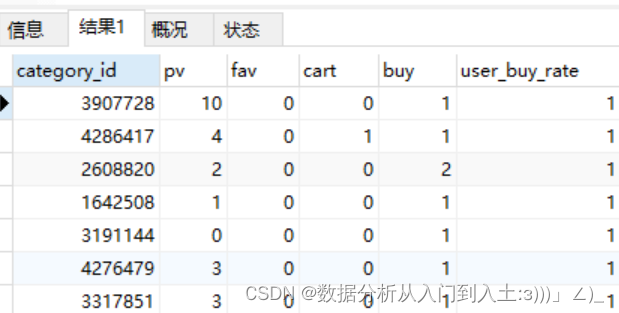
11 商品特征分析
1.点击与购买的关系
矩阵分析,相关分析,分层分析
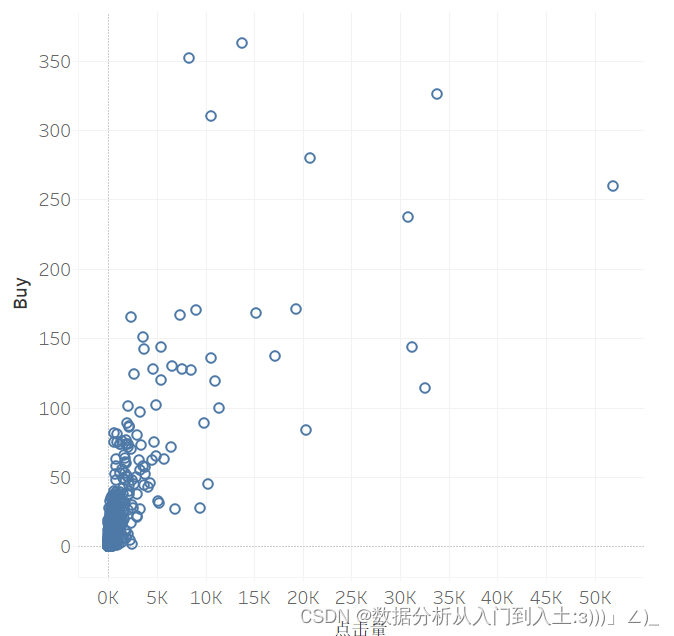
(记得取消聚合)
筛选器:剔除购买量为0的
相关分析
添加趋势线:分析--趋势线--编辑所有趋势线
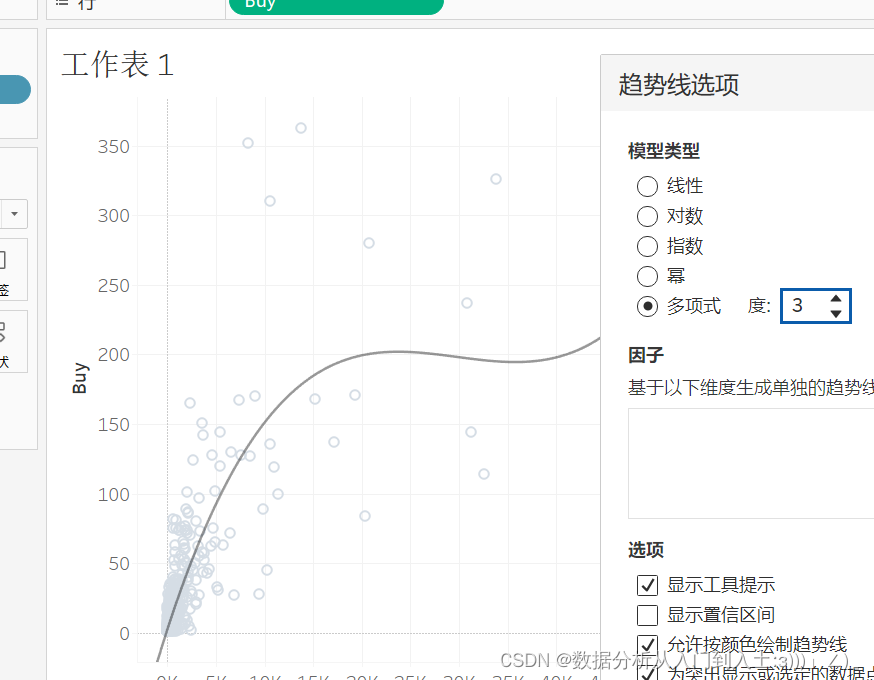
分层分析
添加参考线(平均值)+筛选器
进行点击购买分析
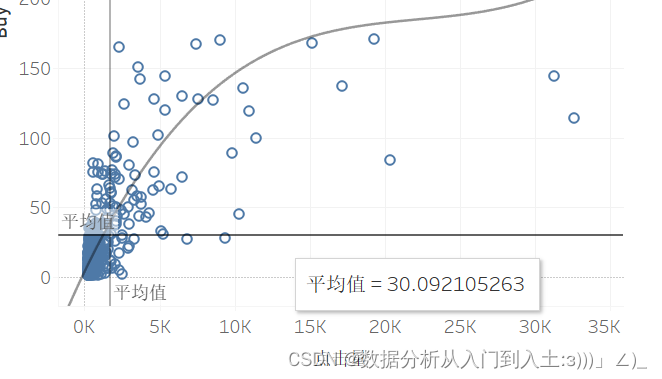
12 数据可视化
使用tableau制作可视化看板,可以取B站搜Tableau相关教程








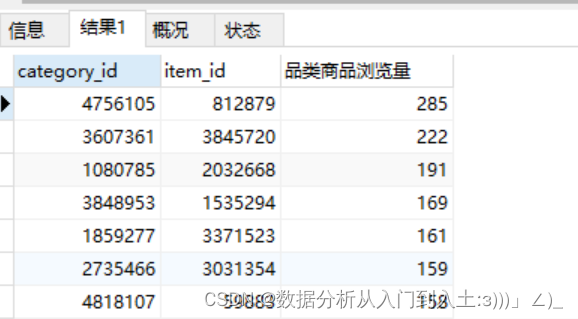














 536
536











 被折叠的 条评论
为什么被折叠?
被折叠的 条评论
为什么被折叠?








